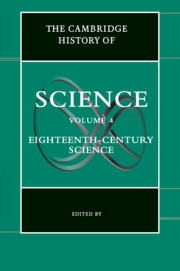27 - Islam
from Part IV - Non-Western Traditions
Published online by Cambridge University Press: 28 March 2008
Summary
The eighteenth century was a period characterized by confrontations, exchanges, and misunderstandings between Europe and Islam. The European commercial and military expansion that began in the sixteenth and seventeenth centuries continued throughout the eighteenth century, and in its wake some early modern European technologies and scientific ideas were introduced into the Middle East. These concepts and technologies coexisted, sometimes uneasily, with medieval Islamic practices. It was a period of ambivalence among Islamic rulers as well as scholars as to the relevance or acceptability of Western science and technology.
The Napoleonic Expedition of 1798 symbolizes the organized introduction of European science, medicine, and technology into the Near East, for engineers and scientists accompanying the expedition to Egypt methodically introduced the latest European ideas while at the same time recording the indigenous technologies they encountered. Prior to that, the introduction of European scientific ideas was sporadic, and occasionally there was a lengthy time lag before their introduction into the Ottoman, Safavid, and Mughal worlds. After its introduction, the integration of a new technology into the culture occurred (if at all) only after a considerable interval of time during which there were social and sometimes ideological adaptations.
Historians have given relatively little attention to scientific, medical, and technological activities in the eighteenth century in the Islamic world. The sources for this period are fragmentary and difficult to interpret. Relatively few treatises written in Arabic, Persian, or Turkish during this period have been studied by scholars, and historians are largely dependent on records of European travelers, diplomats, and missionaries – accounts that are often superficial or prejudiced.
- Type
- Chapter
- Information
- The Cambridge History of Science , pp. 647 - 668Publisher: Cambridge University PressPrint publication year: 2003
References
- 1
- Cited by

